Before the J Class yachts came into existence, yachts were designed to be bigger and bigger. The towering rigs of the Big Boat Class such as ‘ Lulworth ’ and ‘ Britannia ’ dwarfed all other yachts. The late 1920s heralded discussion and agreement of the Universal Rule. This new formula controlled the size and displacement of the new yachts, enabling them to be raced as evenly as possible. Almost immediately, designs were being commissioned for the new, massive ‘Bermudan rigs, with no bowsprits’.
The rule was based on ideas proposed by Nat Herreshoff allowing waterline length to be increased without sail area being restricted, as it had been under the International Rule. This was compensated by a larger displacement and so draught was limited to 15ft.
In 1929 Sir Thomas Lipton, owner of Lipton’s famous for his import of Lipton Tea from India, issued his fifth challenge to the Americans for the America’s Cup. He commissioned the build of the first J Class Yacht which signified the start of a new era in design evolution and racing. On each occasion he challenged for the America’s Cup as a member of the Royal Ulster Yacht Club in Northern Ireland. RUYC are still involved with The Cup – presenting the Royal Ulster Cup to the Club of the winning challenger.
The Universal Rule came into effect in 1930. The size of a yacht was determined (by waterline length) and this was shown as an alphabetical list. “J” signified yachts with a waterline length of between 75 to 87 feet. The addition of the new design Bermuda mast allowed the yachts to carry a huge sail plan. Nothing so large and ‘awesome’ had been built previously. The Americans had a distinct advantage over Britain in the 1930 America’s Cup. They had the money to build four J’s over Britain’s one, yet the British yacht, Shamrock V was a hot contender. She was designed by Nicholson and built at the family yard in 1930, and before she crossed the Atlantic to attend the Cup she had notched up more than 700 sea miles (1,296km), won 15 out of the 22 races she had entered and had been tweaked and tested to a high degree.
In answer to Lipton’s challenge of 1929 the Americans designed four J-Class yachts as possible defenders. Enterprise, Whirlwind, Yankee and Weetamoe were launched within a month of each other; Weetamoe and Enterprise from the Herreshoff yard and Yankee and Whirlwind from Lawley & Son’s yard in Bristol.
Whirlwind, the second J, was the most revolutionary of the four. Francis L Herreshoff had moved away from conventional yachts and designed a boat, which took the new rule to its extreme. Whirlwind combined many new ideas and Herreshoff experimented with hull shape and rig. She was the longest of the early J’s at 86ft on the waterline and remained so until Ranger and Endeavour II were built in 1937.

She was built of semi-composite construction (the other three American Js were built out of the highly expensive Tobin bronze), was double-ended and had a permanent backstay. Uffa Fox described her profile as: “Very pleasing to the eye, the stem sweeping down to the keel in a very sweet line, and to a man who, like myself, believes that a pointed stern is a logical ending for all vessels, her stern is a joy to behold.” He predicted, “If the Yacht Racing Rules govern well and wisely, we shall see Whirlwind racing 50 years hence. If they do not she will probably be cruising then.” But Whirlwind met an early demise. Her building was delayed as she didn’t meet Lloyd’s A1 scantling rules and she wasn’t chosen to be the 1930s defender. She was often out-performed when close hauled, her steering gear making her difficult to steer. She was eventually scrapped along with Enterprise in 1935. However, her unusual double-headsail rig was later adopted by the rest of the Js.
The third American J, Yankee, was the best all-rounder. At 84ft on the waterline and 125ft length overall, she was solidly made of Tobin bronze and was extremely well balanced. Designed by Frank Paine , Yankee had an almost straight sheerline and easy lines. She was a powerful contender for defender, but not fine-tuned enough to succeed. She did, however, take part in the 1934 America’s Cup trials and with alterations to her rig, to carry more sail, and bow, which was lengthened and made more of a V-shape, she then proved more successful, especially in light winds.
The fourth of the American J’s was Weetamoe, which was designed by Clinton Crane and was the narrowest of the early four. Despite claims that Yankee was the best all-rounder, Weetamoe is said to have been the closest rival to Enterprise to be the Cup defender. Charles Nedwick, in Ian Dear’s book Enterprise to Endeavour, describes Weetamoe as having a profile “that is practically a triangle, with a straight line from the after end of the waterline to the bottom of the keel and thence a line which is slightly convex, and then slightly concave to the forward end of the waterline.” In an attempt to better performance and make her less tender, her profile below the water was radically altered in 1934 with a new contour and bulb keel. The alterations failed and not long afterwards were reversed. In common with the other J’s, she had about 43ft of overhang and her hull, Nicholson opined, “was the best of all the US Js”.
When Shamrock V and Enterprise eventually met off Newport, Rhode Island, later that year, the two J’s were well matched in hull profile, but differed significantly in rig. Enterprise’s rigging was lighter, she had the Park Avenue boom, which was so advantageous to windward, and had lots of winches on board. Shamrock V meanwhile, was under-winched and hard work to sail. She has since, however, proved her success in that she is still sailing today.
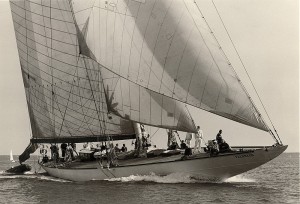
The sixth J-Class yacht to be built, and the second built on British soil was Velsheda . She was the only J not built as a contender for the America’s Cup. Her owner, WL Stephenson, who previously owned White Heather II, the 23-Metre converted to rate as a J-Class in 1930, had Velsheda built in steel in 1933 at the Camper & Nicholson yard. Velsheda was a great success. In 1935 she was significantly altered, her bow was snubbed around the waterline and her stern improved. The following season she won the King’s Cup at Cowes Week.
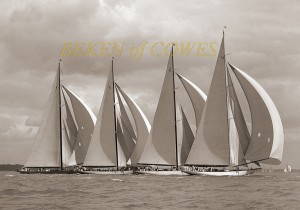
In 1934, Sopwith challenged for the America’s Cup. His challenger was Endeavour . She was Charles Nicholson’s third J-Class design and he said of her “She will have quite a normal hull… because I have thought it right to suppress possible experimental form, which would be most interesting to try out, but which I have to leave to American designers.” He did, however, produce the most beautiful J-Class and her rig was innovative.
Sopwith experimented with new running backstay strain gauges, which controlled the trim of the mast and used electronic windspeed and direction indicators. It has since been suggested that part of the reason for her failure in the Cup was due to all the gadgets on board. She was matched 83ft 3in on the waterline against Rainbow ’s 82ft. However, despite being thought to be the best challenger Britain has ever built, she did not win the Cup. Rainbow, which was considered the inferior boat, beat her by four races to two.

Rainbow was designed by W Starling Burgess and launched in 1934 from the Herreshoff yard where she was built in just 100 days. The J stepped a pear-shaped duralumin mast, designed to take the strain of the double-headed jib – first used on Whirlwind – and she was originally rigged with a Park Avenue boom. This was later removed because it was considered too heavy.
The UK Class was depressed with the death of King George V and scuttling of his yacht “Britannia” off the South of the Isle of Wight, in accordance with his will.
Of the American Js, Yankee was the only one to sail in British waters when she was bought by Gerald Lambert and crossed the Atlantic in 1935. She was scrapped in 1941. Enterprise and Whirlwind were both scrapped in America.
1937 saw the building of the last two J’s on both sides of the Atlantic. Both Ranger and Endeavour II took the waterline length to its extreme, measuring 87ft LWL . Ranger, the American boat, was built at Bath Ironworks in Maine and designed jointly by W Starling Burgess and Olin Stephens . It was a design combination, which produced the greatest J of the fleet – the ‘super J’ as she was later known. She was built, for the cost of the materials only, of flush riveted steel plating and soon after launching had an accident. The upper parts of her rod rigging which stayed her duralumin mast shook loose and her mast snapped “with a report like a cannon”.
Ranger’s success on the water was widespread. Of 37 starts she won 35. Owner-skipper Harold Vanderbilt described her as being “slower to turn and to pick up speed, but (she) held her way longer, and was perfectly balanced on the wind.” The challenger, Endeavour II, was designed by Nicholson again and built at the C&N yard. She too was steel, but flush-plated above and below the waterline. Sopwith towed her and Endeavour, plus an entourage of 100, to America where he worked on tuning her rig. Sadly, Ranger saw off the competition, easily winning four races, and dashing British hopes.
Although they became recognised the most beautiful yacht design in the world, only 10 J Class yachts were ever built – 6 in the USA and 4 in the UK. Most of these competed in trials for the America’s Cup, or competed in the Cup itself. Several existing large British yachts, ‘ Astra ’, ‘ Candida ’, ‘White Heather II’ and ‘Britannia’, the King’s yacht, were all converted to comply with the rule and raced alongside the J’s.
After the victory of Ranger over Endeavour II, Vanderbilt wondered whether the boat was so much faster than the competition that it might kill the class. History would show this was not the case as analysis of the Holm design shows that it would likely have been faster than Ranger.
1937 marked the end of an era – it was the last America’s Cup contest for 21 years and marked the end of Big Yacht racing. Shamrock V was sold to Mario Crespi, the Italian Senator and publisher, who converted her to a ketch rig and renamed her ‘Quadrifoglio’, with a literal translation giving her authentic name of ‘4 leaves’ in Italian. This was in accordance with an Italian law, which forbade foreign names.
Weetamoe was scrapped in this year, while at the end of the season Ranger was laid up, prior to being scrapped in 1941.
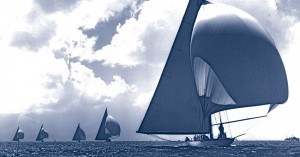

HANDLING THE J CLASS YACHTS IN THE 1930’s
The Skippers had to be experienced in racing and their skill on the race circuit became a matter of pride. These mighty craft had no engines and they had to be handled with great precision to get into and out of ports. Often their experience came from sailing all types of small craft, including fishing boats, during the winter months, when the J Class yachts were laid up. The permanent racing crew in the early days was probably around 16 men thou this may have been augmented to around 30 for racing. When not required for sail changes, spare crew were often moved to below decks.
With the incredible loads on the rigging and systems it was a constant concern that J Class masts could collapse in winds above a Force 3.
Sailing small boats in often inhospitable waters gave them the skills to manage their J Class yachts. The same is true today. Skippers have to deliver their yachts across Oceans, and compete around the race course, using their skills and all the technical advantages that are available today.
It is now clear that there was another J Class Yacht under development in 1937. Several years ago, drawings for a J-Class boat by Swedish naval architect Tore Holm were discovered by Fred Meyer, (Société Nautique de Genève – the Defender of the 32nd America’s Cup).
Now known as the Holm Project, this was to be a Swedish yacht with an innovative design. Many of the hull plates were made – and exist to this day. The project was put on hold prior to the outbreak of War in 1939 and was forgotten for more than 60 years. Endeavour and Endeavour II (K6) were laid up at Camper & Nicholson’s yard in Gosport, England.
Rainbow was scrapped. By the end of 1941, all the US yachts, which had been laid up were scrapped for their metal, with the last two being Yankee and Ranger. None survived. Yankee’s owner Gerard Lambert allegedly donated her scrap money from the yacht to Queen Mary to be used at her discretion in the London Hospital, in memory of the courtesies shown to Yankee by King George and the Queen herself.
Endeavour II was sold for scrap to Charles Kerridge Limited but her hulk remained until the late 1960s. Endeavour and Velsheda became houseboats in a mud berth on the River Hamble. This is where they stayed for more than 30 years, protected by the mud, which they had sunk into. Only Shamrock V was still sailing.
Endeavour II was broken up and scrapped in Southampton. Quadrifoglio (Shamrock V) had been hidden in Italy in a barn throughout the war years and following Crespi’s death in 1962 was sold to Piero Scanu, who saved her just two weeks before she was due to be broken up in Genoa.
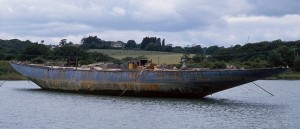
During the 1970s Endeavour’s hulk was sold for £10 and restoration was started.
Quadrifoglio (Shamrock V) arrived from Italy and was refitted at Camper & Nicholson’s yard where she had been built, supervised by Paolo Scanu the naval architect, and son of the owner.
The large holes in Endeavour’s hull were plugged and she was towed to the old seaplane base at Calshot Spit on the Solent to start restoration.
Terry Brabant rescued Velsheda from her Hamble mud berth and gave her enough of a refit to get her chartering and, occasionally, racing again in events like the annual Round the Island Race, hosted by the Island Sailing Club in Cowes. Despite being in rather poor condition she still acquitted herself well and looked magnificent from a distance. Swiss plans to restore her came to nought and the old racing yacht was eventually laid up afloat in Gosport. Elizabeth Meyer took on the challenge to continue with the rebuild of Endeavour at Calshot.
Quadrifoglio (Shamrock V) was purchased in 1986 by the Thomas Lipton Company, and given back her original name of Shamrock V, when she became the property of the Newport Museum of Yachting. Endeavour was towed from Calshot, to Cowes on the Isle of Wight to have her fittings and rigging fitted. She was then taken on a barge to the Royal Huisman Shipyard in Holland to continue and complete the rebuild.
Endeavour was relaunched in Holland. Endeavour and Shamrock V match raced each other over the Old America’s Cup course in Newport, Rhode Island in August.
Velsheda was purchased from a bankrupt C&N boatyard and brought to Southampton Yacht Services to start her rebuild. She was relaunched in 1998 and started her programme of racing and cruising around the World.
Velsheda, Shamrock V and Endeavour raced against each other in Antigua Classic Week.
The Owners met in England and formed the J Class Association to protect the interests of the Class, present and future. Class Rules were established for the construction of Replica Rebuilds from original plans. Shamrock V came out of a major refit at Pendennis in Falmouth under the supervision of the Dykstra office.

The first J Class Regatta is held in Christchurch Bay on England’s south coast over three days, followed by the Jubilee Regatta in Cowes.
Ranger replica was commissioned and construction started at Danish Yacht Shipyard.
Ranger was launched and started her racing programme.
Replicas of Endeavour II (Hanuman) and Ranger (Lionheart) are commissioned.
Replicas of Rainbow and Paine design (JH7) are commissioned.
Hanuman, replica of Endeavor II launched.
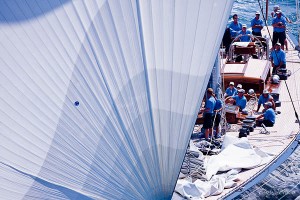
Lionheart launched.
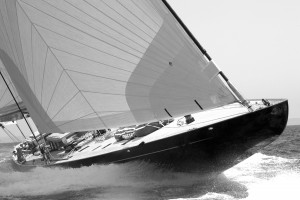
Rainbow launched. Cheveyo commissioned from Sparkman & Stephens / Spirit Yachts.

Information courtesy of the J Class Association
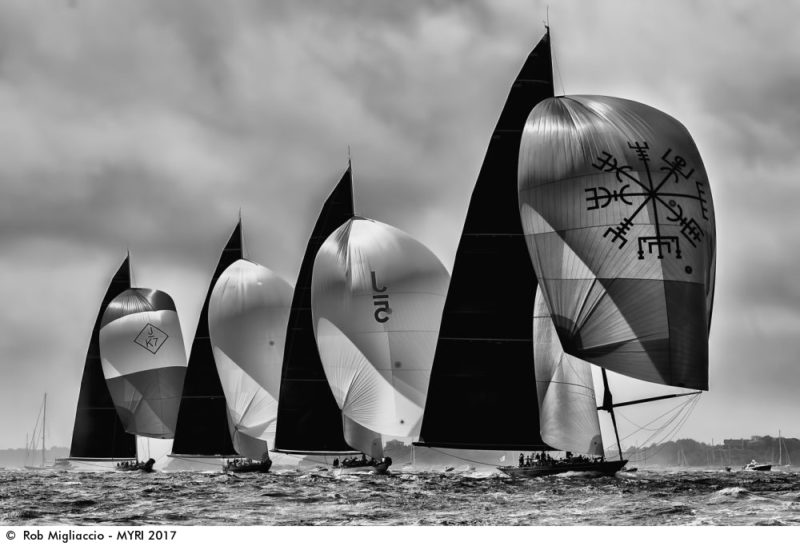
Svea, Velsheda and Topaz at the St Barths Bucket, 2018.

SHARE THIS:
- Yachts for Sale

Recently updated...
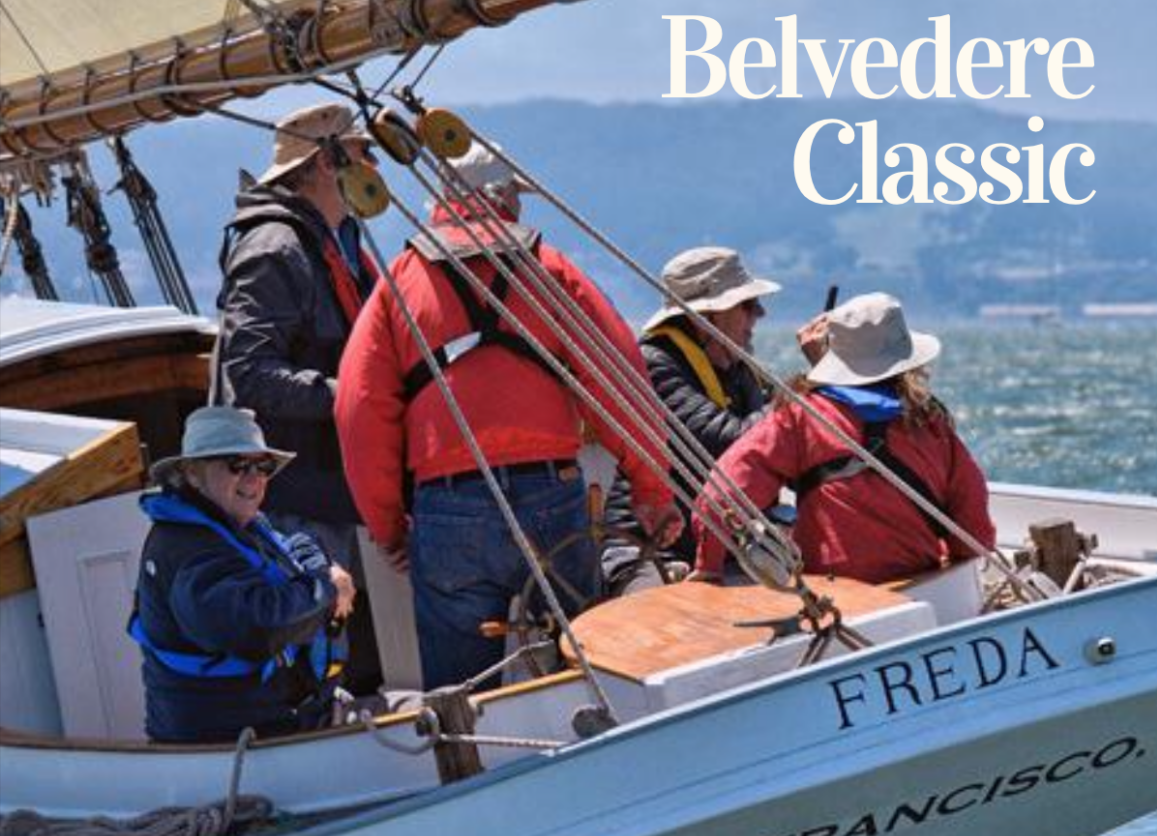
Write an Article
Covering news on classic yachting worldwide is a tall ask and with your input Classic Yacht Info can expose stories from your own back yard.
We are keen to hear about everything from local regattas and classic events to a local restoration or yachting adventure. Pictures are welcome and ideal for making the article more engaging.
With a site that has been created with the assistance of an international group of classic yacht enthusiasts we value your input and with your help we strive to make CYI more up-to-date and more informative than ever.
Please register and get in touch if you would like to contribute.
Submit a Classic Yacht Book
Expand the CYI reading list by adding a book of interest that covers one of the many areas of Classic Yachting.
As a site that has been created with the assistance of an international group of classic yacht enthusiasts we value your input and with your help we strive to make CYI more up-to-date and more informative than ever.

ClassicYachtInfo.com has the largest database of classic yachts on the internet.
We’re continually working to keep it accurate and up-to-date, and we greatly appreciate contributions of any type. If you spot an error, or you have some information on a yacht and would like to contribute, please jump on in!
Don’t be shy…. Breeze on!

We’re passionate about Classic Yachts here at CYI, and we welcome submissions from all over the globe!
Captain, rigger, sail-maker or chef – if you’d like to write for CYI just let us know!
Email [email protected] to be set up as a Contributor, and share your Classic thoughts with the world.
- Sell Your Yacht

Published on June 26th, 2017 | by Editor
Return of the J Class Yacht
Published on June 26th, 2017 by Editor -->
J Class yachts , which reigned supreme in the 1930s, are making a thrilling comeback, with restorations, new builds and the biggest fleet the class had ever seen at the America’s Cup J Class Regatta . Why wasn’t the event broadcast, people asked. One theory was the fear of higher viewership than the actual America’s Cup.
In this report by Matthew Sheahan , he charts a return to glory for the class.
Only 10 were ever built from just 20 designs and their reign lasted less than a decade. In their day, J Class yachts were the most technically advanced and universally admired yachts in the world. They drew royalty and captains of industry aboard, while regularly pulling big crowds of spectators to vantage points ashore. But the death of a sovereign, who regularly raced one, and the threat of a world war saw them disappear as fast as they had arrived.
Of the 10 that were raced between 1930 and 1937, six were built in America and four in the UK. Three of the British boats survived, but only just, while all the American ones were scrapped.

Conceived in 1930 as a more affordable alternative to the previous generation of expensive, one-off America’s Cup yachts, now, more than 85 years later, J Class is about to hit a new high. In 2017, seven J Class owners raced their boats in Bermuda – the biggest fleet the class had ever seen ( see photos ).
Of the original examples that still existed, Endeavour was the first to be fully restored back in the 1980s. Velsheda and Shamrock V followed. Since then, all three have been newsworthy sights at some of the most famous yachting venues around the world. From there, fascination with the Js continued, but with no original boats to restore, people started building replicas.
The first was the American yacht Ranger. “When we launched her in 2003 she was the first new-build J Class yacht for 66 years,” says owner John Williams. “I have had a number of large yachts over the years, but owning a J Class is like owning an F1 car, you simply can’t go back.”
The launch of Ranger, combined with Williams’ success on the water, inspired the construction of others, including Hanuman, the modern interpretation of aviation pioneer and yachtsman Thomas Sopwith’s 1936 J Class, Endeavour II.
Indeed, it was the competition between Endeavour II and the original Ranger that rekindled interest in the last J Class battle for the America’s Cup in 1937, when Harold Vanderbilt wiped the floor with Endeavour II in a match that brought down the curtain on prewar J Class activity and the class itself.
Some owners are now even building yachts from original 1930s lines plans that were never actually constructed. Lionheart was the first– one of seven rejected Ranger models from 1936. Svea, which launched earlier in 2017 ( see photos ), is the latest example – based on an original Tore Holm design from 1937, brings the total in the J Class fleet to nine.
Over three decades, J Class fever has taken a hold at a price tag of around $16.5m apiece. They are expensive boats to run too, costing around $1.3m to $2.5m per year for a racing J. The most competitive might even have new sails for each regatta, so with a single genoa priced at around $127,000, campaigning these boats is not for those looking to compete on a modest budget. And herein lies part of the appeal.
A J Class is not simply a type of yacht – it’s a phenomenon and has always attracted the world’s wealthiest individuals. In addition to Sopwith, Vanderbilt, George V and tea magnate Thomas Lipton were among the famous owners on both sides of the Atlantic. As well as satisfying a personal zest for yacht racing, the boats drew attention that often helped develop their global businesses.
Today, many current owners are equally accomplished, whether as captains of industry, technology or the internet, but in contrast to their forebears many prefer anonymity and are discreet about their professional backgrounds. That said, they are just as besotted with what are described as the most beautiful yachts in the world. Such is the legacy of the J that many see their ownership as simply custodial, even if the boats are replicas.
Back in 1984, American writer and businesswoman Elizabeth Meyer kick started the reincarnation of the J Class when she bought the derelict and barely floating hulk of Endeavour. One of the most famous of all the Js, Endeavour is still widely considered to have been Britain’s best chance of winning the America’s Cup in over 160 years. A full restoration programme saw the yacht back afloat in 1989.
“The size and beauty of these boats is a huge draw. It is hard to make a boat look as beautiful as a J does – there is some magic to it,” says Dutch businessman Ronald de Waal. As the owner of Velsheda, he admits to being hooked on the class. “Their history is also an attraction. They all have a big provenance.”
De Waal’s involvement started almost by accident but quickly led to Velsheda’s full restoration from a bare hull and deck. “I had bought a 40m yacht that caught fire during trials, which led to me looking for another boat,” he explains. “Yacht designer Gerard Dykstra found out there was a J Class hull that had been confiscated after the boatyard restoring it ran into financial difficulties. I paid off the shipyard and the bank, bought the hull and set about restoring the boat, and in 1997, she was launched.”
De Waal is the longest-serving J Class owner and remains very active on the racing scene. His enthusiasm and support, along with Dykstra’s design expertise, have been instrumental in the development of the current fleet. Where Meyer was the catalyst, De Waal and Dykstra have created solid foundations for the class. “To own a boat like Velsheda is to own something that is irreplaceable,” says De Waal. “It’s not just about the money, it’s the history and the almost spiritual feeling about the boat and what she stands for. It reminds me of life and living, it’s that strong a connection.”
Dykstra and his design team have been involved in no fewer than six different Js, with another on the drawing board, and remain closely involved with the practical day-to-day aspects of running a J campaign. “When you step aboard a J, you are not just a sailor but a part of yachting history,” says Dykstra. “The sailing is impressive, but it’s impossible not to be affected by the sense of heritage and the part these boats have played. They drew huge crowds in their day, and today’s spectators are equally fascinated.”
While the J Class continues to epitomise all that was grand, elegant and competitive about yacht racing in the 1930s, the reality is that these boats were, and remain, challenging brutes to handle. Not surprisingly, their immense power and complexity attract some of the world’s top professional sailors.
Jeroen de Vos at the Dykstra design office is one of several staff who sail regularly on Js. “Of the 30 or so crew aboard, more than 20 need to be highly experienced sailors,” he says. “You have to work flawlessly as a team because the boats are so powerful that the slightest mistake can result in a serious situation. The level of competition is also extremely high.”
Following the racing in Bermuda, the aim of the fleet is now the 2017 J Class World Championship on August 21-26 in Newport, RI
Sharing the credit for the new wave of Js is designer Andre Hoek who has created five of the modern Js. His work has concentrated on yachts like Lionheart and Topaz, modern builds from original lines.
“The move to aluminum as a construction material has been a big step for the class and one of the key factors in their current appeal,” he says. “Originally the boats were stripped-out racing machines built from steel. Today, owners want full interiors with creature comforts and systems that allow them to cruise the boats as well. A lighter aluminium build means they can have these interiors and still float to their original lines.”
Another key factor has been the clever handicapping system that ensures equitable racing at all the events. The handicap system was originally developed by Dykstra in conjunction with technical experts at the Wolfson Unit at Southampton University, which required detailed performance analysis. Andre Hoek’s team has also spent time assessing the current and future performances of the Js, but for subtly different reasons.
“We conducted a huge amount of research with velocity prediction programs to assess the various performances of the boats, both those that had been built and those that were just designs,” says Hoek. “The result is we now know more about why certain hulls work and others don’t. We can also see which of the original designers were working along the right lines.”
The willingness and enthusiasm of owners to take their elegant yachts to the mid-Atlantic island of Bermuda in June 2017 is testament to both the continued pull of the America’s Cup and to the historical significance of the J Class.
“It’s rare for a venue to host more than a few boats, but the Hamilton Princess hotel in the centre of the town provided berthing for all the Js,” says J Class Association secretary and event organiser Louise Morton. “This created an incredible spectacle, right at the heart of the event.”
J Class yachts could not be more different from the modern, lightweight, high-speed, hydrofoiling catamarans that are the current America’s Cup boats.
A J Class has a single 41m hull, a lead keel and over 900sq m of sail. She requires around 30 crew, weighs around 150 tonnes and has a typical maximum speed of 12 knots (14mph). A modern America’s Cup catamaran is 15m long, has two hulls, flies above the water on hydrofoils at speeds approaching 52 knots (60mph) and is powered by an aeroplane-style wing sail. The boat is sailed by just six crew and weighs only 1,320kg.
On the face of it there is no comparison, yet they share the same DNA. Just as current foiling catamarans are defining new limits, the Js of the 1930s represented the leading edge of yacht design and construction, their size and loads pushing at the limits of what was technically possible.
But it wasn’t just the boats and their towering 50m masts and colossal sails that were breaking new ground; systems and technologies developed elsewhere on the boat were also helping to shape the modern era of both racing and cruising yachts. A good example is the development of electronic sailing instrumentation for information on wind strength and direction. First used on Sopwith’s J Class Endeavour II, such instrumentation soon became commonplace.
Even to this day, such technical developments have continued. “In the early 1990s, the winches on these boats were manually powered by the crews winding pedestal grinders,” explains Dykstra. “Now those grinders have been replaced with hydraulically powered winches that allow crews to handle the boats more efficiently. It has changed the game and led to more advanced systems and new sailing techniques.”
So while the enthusiasm for this classic yacht may appear to be driven by nostalgia, the boats are continuing to do exactly what they were originally designed to do – push the boundaries and create the ultimate racing machine. Sometimes history repeats itself in unexpected ways.

Tags: America's Cup , America's Cup J Class Regatta , J Class , Matthew Sheahan
Related Posts

Video Series: The 5 Minute Warning →
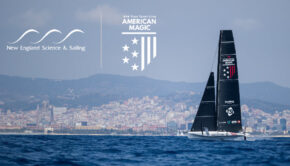
Bringing the America’s Cup into the classroom →

Ep9: Road to the 37th America’s Cup →
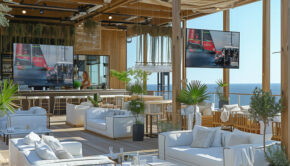
Going to Barcelona for the America’s Cup →
© 2024 Scuttlebutt Sailing News. Inbox Communications, Inc. All Rights Reserved. made by VSSL Agency .
- Privacy Statement
- Advertise With Us
Get Your Sailing News Fix!
Your download by email.
- Your Name...
- Your Email... *
- Comments This field is for validation purposes and should be left unchanged.


The global authority in superyachting
- NEWSLETTERS
- Yachts Home
- The Superyacht Directory
- Yacht Reports
- Brokerage News
- The largest yachts in the world
- The Register
- Yacht Advice
- Yacht Design
- 12m to 24m yachts
- Monaco Yacht Show
- Builder Directory
- Designer Directory
- Interior Design Directory
- Naval Architect Directory
- Yachts for sale home
- Motor yachts
- Sailing yachts
- Explorer yachts
- Classic yachts
- Sale Broker Directory
- Charter Home
- Yachts for Charter
- Charter Destinations
- Charter Broker Directory
- Destinations Home
- Mediterranean
- South Pacific
- Rest of the World
- Boat Life Home
- Owners' Experiences
- Interiors Suppliers
- Owners' Club
- Captains' Club
- BOAT Showcase
- Boat Presents
- Events Home
- World Superyacht Awards
- Superyacht Design Festival
- Design and Innovation Awards
- Young Designer of the Year Award
- Artistry and Craft Awards
- Explorer Yachts Summit
- Ocean Talks
- The Ocean Awards
- BOAT Connect
- Between the bays
- Golf Invitational
- Boat Pro Home
- Superyacht Insight
- Global Order Book
- Premium Content
- Product Features
- Testimonials
- Pricing Plan
- Tenders & Equipment

Svea: Inside the newest member of the J Class fleet
Silhouetted against the Mediterranean sunset, Svea ’s overhangs are awesome to the point of outrageousness. Her original profile was based on an analysis of the development of the J Class after the 1936 match racing series.
The Swedish naval architect and boatbuilder Tore Holm, famous for his Six Metre and Eight Metre class racing yachts, had turned his pencil to the far bigger Js and he set out to design to the longest LOA the class would allow. He had completed his yacht’s lines and sailplan in 1937 just before the Second World War changed the world’s priorities and, with it, sailing and the great and glorious international regattas, including the America’s Cup . Europe would take decades to recover economically and when it did the J Class seemed a little anachronistic.
Holm himself was a proud Olympic sailor from a boatbuilding family in Gamleby, Sweden. So it would not be a stretch to imagine him designing a yacht for Sweden’s elite to take on Europe’s best. Even though he continued designing boats into the 1950s, mostly Skerry cruisers and international classes, his J Class plans remained in a drawer.
J-S1 probably would have remained a ghost except for a trio of coincidences. The first was when the secretary of the International Eight Metre class, John Lammerts van Bueren, received permission from Holm’s heirs to comb through his drawings for plans of un-built Metre classes. In the attic of the family home, he came across the unmistakable plans of a J Class signed by Holm in 1937.
The second coincidence was that Lammerts van Bueren was good friends with Dutch naval architect Andre Hoek. Hoek was fascinated by the discovery and assembled a group, including a potential owner, to buy the rights to the design.
“We could see that there was a growing interest in the J Class,” says Hoek. His firm Hoek Design Naval Architects had earlier been hired to analyse the 1936 designs Sparkman & Stephens and Starling Burgess made for the replacement of Harold Vanderbilt’s 1930 Cup winner Enterprise , an exercise that led to the building of the original Ranger . Hoek’s task in 2005 was to find a design that could be updated to the modern class rules. This became Lionheart , which was launched in 2010.
“The discovery of the Holm J was exciting,” says Hoek. “We had developed a velocity prediction program specifically to analyse the lines and sailplans of classic displacement sailing yachts with long keels and attached rudders. We ran the lines of every known J through the program. We took the five designs that seemed to perform the best and subjected them to computational fluid dynamics to simulate tank and wind tunnel testing; then the data really got interesting! The Holm boat indicated it would be a very powerful performer.”
His team set about modernising the design to the new class rules. Construction started and with the two halves of the hull and deck completed, the owner pulled out, leaving the builder, Claasen Shipyards , with the unfinished hull and Hoek in search of another potential owner.
Enter coincidence number three — an avid racer who wanted to be able to sail in the America’s Cup Superyacht Regatta and J Class Regatta in Bermuda last year. The owner’s fleet manager picks up the tale. “He saw five Js racing at the Superyacht Cup and that was pretty impressive and twice we were involved in regattas where Js were competing. He sailed Endeavour and had chartered Rainbow for the Cowes Centennial, but then that boat sold,” he explains, adding that his boss also had the opportunity to sail Lionheart and Hanuman .
When he learned of the opportunity to buy the hull and deck of the Swedish design from Claasen, the owner took it, realising that that was the only way he would be able to make the event in Bermuda on his own boat. And so began the programme to finish a J Class from a bare hull in just 14 months. The build was completed at Vitters , which had arranged a partnership with Claasen.
Tako van Ineveld, formerly a director at Holland Jachtbouw , had been involved with the build and sailing of Rainbow . Now heading his own independent project management company, he was the perfect choice to direct the build of Svea as the owner’s representative. First on the list of modifications for the new owner was the addition of a doghouse and a revision of the deck layout.
Originally the wheel was mounted on deck like Endeavour ’s and there was no cockpit, notes Hoek. “But it is such a big wheel that it’s hard to put a lot of pressure on it unless you are on the centreline, but at times you really need to see what’s happening on the lee side. We felt it would be better to create a shallow cockpit and recess the bottom of the wheel in a well to give the helmsman a better position.” Unlike many of the details of the J Class, the layout and dimensions of the cockpit and the position of the wheel and winches are not part of the regulations.
Svea ’s cockpit is one of the standout features. Hoek and the owner’s team revised the plan, essentially splitting the sailing functions into two cockpits. The afterguard — helmsman, tactician, main and jib sheet trimmers and the team on the running backstays — are in constant visual communication and within easy hearing distance of each other while the halyard and spinnaker trimming winches and their crew are forward of the doghouse.
It’s an inspired set-up for fast, quiet communication, says Vittorio Papa of the Hoek Design office, noting there are no winches behind the helmsman. When in cruising mode, a U-shaped framework clips in around the edge of the cockpit to provide comfortable seating for 10 around a gleaming teak table.
“The owner has an experienced racing team and they took the lead in working with Southern Spars, Harken and North Sails in concert with the engineers for the yard,” said van Ineveld. “From a sail handling point of view, she is likely to be the most aggressive J yet.”
The owner wanted an interior with an owner’s suite plus two en suite guest cabins, a comfortable combination saloon and appropriate quarters for six permanent crewmembers. He chose Pieter Beeldsnijder to draw an interior that would nod to the classics, but not become a costume drama. For example, the joinery is open grain matt-varnished walnut and the simplified raised panels are off-white. Hardware is a tasteful gunmetal that complements the carbon fibre spars and sails and the deep grey pearl of the topsides.
One of the more modern interior features of Svea is a drop-down wall panel between the galley and saloon that creates an informal breakfast bar. While the cabinetry looks rich, 80 per cent of the interior is veneered foam core to save weight. The added teak doghouse is carbon fibre with teak veneer.
Sadly, in the middle of the project Beeldsnijder passed away. While Hoek Design transferred his hand-drawn sketches to AutoCAD details, Michiel de Vos of deVosdeVries Design was brought in to complete details for interior manufacturer List and choose soft goods with the owner.
In the small town way in which everything in maritime Holland seems just a few degrees of separation apart, de Vos formerly worked with Beeldsnijder before starting his own firm and earlier sailed as second engineer on the J Class yacht Shamrock V .
First and foremost, Svea is a racing yacht and the owner is committed to providing everything to work towards victory, says Captain Paul Kelly, a veteran of the classic schooners Borkumriff IV , Atlantic and Eleanora . Part of that commitment was assembling his 2017 race crew to sail on the boat in sea trials in Holland and then to assemble for full-on practice throughout April in Palma.
“We have the benefit of 20 years of development on Ranger and five or six on Lionheart ,” notes Kelly. “I think we are in a better position right out of the packet. Of course, they have the years of practice but our 28 crew have really settled into their roles.” All of the permanent crew also race.
“ Svea is an absolutely incredible fusion of 1937 design and 2017 technology,” says Kelly. “We look like 1937 but strip away the veneer and we are as modern as they come.” Contrasting the J with his previous charges he is quick to note “this one is a lot easier to drive”.
Moder Svea, which translates from Old Norse as “Mother Sweden”, has been the patriotic symbol of the country since the mid-1600s. Usually depicted as a powerful female warrior, Svea seems the perfect name for the yacht that carried her country’s seafaring heritage onto the world stage when the Js did battle during an America’s Cup for the first time since 1937.
First published in the June 2017 edition of Boat International .
More about this yacht
Similar yachts for sale, more stories, most recent, from our partners, sponsored listings.
J-class yachts
- Browse Lists by
- Film Decade
- Motorcycles
- Car of the Month
- Destinations
- Men’s Fashion
- Watch Collector
- Art & Collectibles
- Vacation Homes
- Celebrity Homes
- New Construction
- Home Design
- Electronics
- Fine Dining
- Les Marquables de Martell
- Mira Villas
- Panther National
- Reynolds Lake Oconee
- Wynn Las Vegas
- 672 Wine Club
- Sports & Leisure
- Health & Wellness
- Best of the Best
- The Ultimate Gift Guide
The 10 Best Explorer Yachts for High-Seas Adventures
A 350-foot gigayacht or 60-foot cruiser size isn't what defines an explorer yacht. the devil's in the details when it comes to authenticity., julia zaltzman, julia zaltzman's most recent stories.
- This Boatmaker Builds 1960s-Inspired Cruisers With a Modern Twist. Here’s How.
- This 150-Foot Fishing Trawler Was Transformed Into a Rugged Explorer Yacht
- These 3 Miniature Explorer Yachts Are Ready to Take You Off-Grid
- Share This Article

Unlike fashion trends that seem to move as fast as a Redbull F1 car, the yachting industry takes its time adopting new ideas. There seems to be one exception. Explorer vessels, born out of the owners’ desires to go farther and stay longer, without sacrificing creature comforts, is developing with some urgency.
Several dozen builders and designers are now focusing on explorers, but they are also consulting with adventure travel firms that have a long history of using expedition yachts in remote parts of the globe. ICON Yachts, for example, collaborated with Cookson Adventures and the International Seakeepers Society on its Project Mission in both the overarching design and the details found across the yacht. Adventure outfitter EYOS employs its expertise routinely with Damen’s explorer vessels, most recently with the 190-foot Pink Shadow. EYOS has a list of 50 features that separate authentic explorers from faux versions that might look the part but lack the necessary infrastructure and design elements.
Long-range cruising, system redundancy for autonomy at sea, and storage to carry specialist equipment like submersibles are some of the requirements that define expedition boats. There’s also deck configuration for the easy launch of tenders and toys, along with strong, ice-class hulls and climate-controlled areas comfort in extreme polar and tropic regions.
We culled through the latest fleet of explorers with multiple lengths and designs, selecting a single feature that we think makes it best in class. Here are 10 of our favorites.
Best Pilothouse: Doggersbank 77 Offshore

More than 700 Doggersbank motoryachts have been built since the 1960s, with the latest model scheduled for delivery in 2025. The robust, offshore vessels are designed by Dutch studio Vripack for long ocean passages, assisted by a high, flared bow. “It prevents green water from hitting the wheelhouse windows in rough seas, and together with the Portuguese bridge, ensures the captain’s view is not obstructed,” Joost Mertens, Doggersbank fleet manager, told Robb Report . “The yacht’s steel hull ensures the yacht sits better in the water making it less vulnerable to wind and high waves.”
Best Deck Configuration: Columbus Crossover 42

The Columbus Crossover 42 is defined by both straight and angled surfaces, tapered stern sections and a concentration of volume in the bow that is becoming on many explorers. What is atypical is the yacht’s compact but flexible dimensions that accommodate a large cockpit tender and a 108-square-foot swimming pool with relaxation areas. Sold to an U.S. customer, it’s scheduled for delivery in 2025.
Best Multipurpose Stern: Bering B165

Turkish boatbuilder Bering Yachts revealed details of its new 162-foot flagship explorer yacht, the B165 , at the Dubai International Boat Show in March. The yacht can carry 18,400 gallons of fuel, which the builder says will give it a 4,000 nautical mile range when cruising at 12 knots. It also has a 2,640-gallon holding tank. What singles the B165 out among other explorers, however, is its multi-purpose stern area for both function and form. The elongated aft deck has a swimming pool surrounded by sunbeds. When the bulwarks are folded down, the space becomes an even larger overwater terrace. When the pool is not in use, it can be used as a covered storage area for water toys and expedition equipment. The yacht’s two tenders are also stored on the aft, making it a flexible space for both equipment and guests.

Best Family-Friendly Concept: Project Mimer

This 197-foot expedition concept by Tillberg Design of Sweden caters to family travel with a helicopter pad as well as multiple tenders and toys. It’s pitched by the studio as an introduction to true explorer yachting. It has a functional crew layout for efficient operations and an upper deck owner’s suite with a forward terrace and spa pool. With a hull that will be built to the Polar Code Category, the concept also has an optional helipad aft and long list of toys, from an electric luxury tender and two expedition RIBS to quad bikes, a submersible, Jet Skis, and, of course, an amphibious vehicle. The five-decked yacht sleeps 12 guests with crew quarters for 17 and an additional staff member, such as a nanny.
Best Ice Explorer: Damen SeaXplorer 105

Damen’s 345-foot SeaXplorer 105 is the largest model in the SeaXplorer range, with exterior design by Azure Yacht Design. The platform was developed under the guidance of expedition specialists EYOS Expeditions, who considered over 150 design criteria, from the hull form and bridge layout to the tender davits and Zodiac boarding arrangements. But it is EYOS’s expertise in the polar regions—it facilitated the first heli-ski charter in Antarctica and the first 3,200-foot sub dive to the Antarctic midnight zone—that gives the vessel its point of difference. The SeaXplorer has an ice-strengthened hull and a specially shaped icebreaking stern to maneuver through rough terrain.
Best Interior: Project Fox

On top of having a cool name, Project Fox has a bright, contemporary interior, courtesy of London’s Q Design, that is becoming more common on expedition yachts. The full-beam owner’s stateroom is also one of the yacht’s standout features, with its marble en suite and hardwood floors. The salon is also luxe, with white walls that brighten up travel even in areas that are sunlight deprived. Project Fox also has four other staterooms.
Best Autonomy: Project Master

ICON Yachts’s Project Master was a transoceanic offshore support vessel before the Dutch shipyard began a refit to turn it into an explorer yacht (see before and after inset). It’s equipped with diesel-electric hybrid propulsion, a wide beam for multiple tender spaces, a 7,200-nautical mile range, and flexible cabin arrangements for expedition crew. Other features include a science lab and a certified heli-deck. “The yacht’s helicopter and sub capability mean it can offer assistance in areas with challenging access and little infrastructure,” Micca Ferrero, owner of ICON Yachts, told Robb Report . “The design is for the demands of self-sufficient voyages.”
Best Use of Volume: Arcadia Yachts A96

The A96 mixes the lines, volume, and open-plan layout of Arcadia’s Sherpa series with the speed, joystick maneuverability, and quality of the yard’s A range. It’s the first Arcadia to have an Igor Lobanov-designed interior, as well as a high bow and high deckheads for traversing rough water. But its big differentiator is the 214 gross tonnes of volume and 24-foot beam that generate big volumes—4,300 square feet of usable space, which is 30 percent more than on other similar-sized yachts. Low bulwarks and lateral walkways emphasize the sense of openness.
Best Bow: Project Shackleton

This 351-foot build from Lürssen has an inverted bow that looks like an eagle’s beak. The shape is designed to slice through waves with much lower vibration through the hull, while also reducing rock and roll in rough seas. Unlike the quasi-research vessel exteriors of many explorers, this vessel is representative of the changing look of many in this growing segment.
Best Multi-Mode Hull: Azimut Magellano 60

The Magellano 60 isn’t technically an explorer yacht. Think of it as a cruiser designed for some long-distance travel. But it does have one very interesting feature, what its builder Azimut calls a “dual-mode” hull. The semi-planing shape is designed to optimize fuel consumption (and therefore lower emissions) by about 20 percent (compared to similar-sized vessels) at low and medium speeds. The yacht’s bow is also designed to cut through waves for better seakeeping at a range of speeds. The boat cruises very efficiently at 18 knots but will hit a top end of 26, thus delivering the performance of a planing hull with the benefits of a displacement hull.
Read More On:
- Expedition Yachts
- Explorer Yachts
More Marine

This New 131-Foot Superyacht Concept Brings High Architecture to the High Seas

ISA Unveils a Trio of Sleek New Superyachts

Wider Yachts Is Debuting a 92-Foot Hybrid Catamaran at the Venice Boat Show—Here’s a First Look

Killer Whales Sunk a 50-Foot Sailing Yacht in the Strait of Gibraltar

Culinary Masters 2024
MAY 17 - 19 Join us for extraordinary meals from the nation’s brightest culinary minds.
Give the Gift of Luxury
Latest Galleries in Marine

K Superyacht in Photos

Meet ‘Home,’ the Sleek 164-Foot Superyacht That Starred in ‘Below Deck’
More from our brands, mara hoffman to shutter business after 24 years, no a’s in attendance: oakland trails a whopping 553 u.s. teams, korea box office: ‘if’ and other new releases make little impact as ‘the roundup: punishment’ hits $75 million, artist joseph awuah-darko accuses kehinde wiley of sexual assault, the best yoga mats for any practice, according to instructors.
Yachting World
- Digital Edition

J Class picture highlights: spectacular images of 7 J Class sailing together at the 35th America’s Cup
- Toby Hodges
- June 21, 2017
The largest collection of J Class yachts yet – seven of the now nine strong J Class fleet – raced during the America’s Cup in Bermuda in June.

It is a sight many sailors have looked forward to as much or even more so than the America’s Cup itself – Seven J Class , the largest fleet to ever assemble in the 87 history of the class, raced in their own regatta either side of the first weekend of the America’s Cup finals.
The J Class also performed a stunning exhibition race on the America’s Cup course on the Great Sound on Saturday, shortly before the first America’s Cup match, for the thousands of fans in the America’s Cup village. (The shallow, reef-strewn depths of the Great Sound make it very tricky to set a proper course for the J Class, hence the actual races were held off the north coast of the island).
A combination of having some of the world’s best photographers here and the J Class racing on translucent turquoise blue seas means the resultant photographs (below) make for a visual treat.
Lionheart scored a first and second on the final day to win the J Class regatta, which concluded in a light breeze off the north coast of the island. It was reduced to a two day, five race event after Friday’s racing was canceled due to light wind.
The fleet was also without its newest member Svea for the final three races, after she suffered rig damage durig the second race (pictured below). But the crews at the prize giving were all delighted with how close the racing was in the light, flat water conditions – a fleet divided and decided literally by seconds.
Here is the best of the Js in Bermuda in pictures

Seven J Class hit the startline for the first time ever. The smaller Shamrock chose port hand starts to keep clear air – Studio Borlenghi

JK7 Velsheda and JS1 Svea add some colour to the otherwise black and white sail wardrobe – Studio Borlenghi

The long aft overhangs of JK6 Hanuman during Monday’s triple race day – Chris Cameron

The precarious pointed bow of a J Class highlights the skill of the bowman. Topaz on the greener, clearer waters of the Great Sound – Ricardo Pinto

The Js dance elegantly around the Great Sound off the America’s Cup village during the J Class exhibition – Ricardo Pinto

The exhibition saw staggered starts in a light breeze but a perferct opportunity to see the skills involved with getting the vast sails up and down around a simulated race course – Ricardo Pinto

Hanuman leads Ranger and Svea during the first day of the windward/leeward J Class Regatta. The final results came down to seconds. Chris Cameron

The view from the weather rail of Shamrock as the six other Js round the mark ahead, Velsheda leading. The smaller Shamrock can only try and compete with the others on handicap.

Preparing to hoist on the foredeck of Hanuman. She has been highly optimised and is the only J to use a snuffer to allow faster kite drops on mark roundings. Ricardo Pinto

The view from the America’s Cup village as the J Class perform their exhibition race. Sander van der Borch

Kristy Hinze Clark, Hanuman’s owner, enjoys helming the boat during the exhibition match – Studio Borlenghi

Onboard the newest J Svea, with her clean deck layout and extra large wheel, with Ranger and Hanuman chasing – Studio Borlenghi

Velsheda’s foredeck crew, led by Jeff Reynolds and Eduard van Lierde prepare to hoist the red white and blue spinnaker – Ingrid Abery

Weight forward on Lionheart on their way to winning both the Superyacht Regatta and J Class regatta in the light airs of Bermuda – Ingrid Abery

The seasoned competitors Ranger (left), Velsheda and Lionheart find their lane at the leeward end of the line – Studio Borlenghi

A seven strong fleet means it’s a gutsy affair at the pre-start and a good reason why the top pros are needed aboard to make the split-second calls – Studio Borlenghi

Bermuda’s picture postcard conditions. The combination of enticingly clear, flat water, ideal temperatures, light breezes and welcoming locals makes for a spectacular venue – Ricardo Pinto

The newest J Class, a Hoek rework of a Tore Holm design, looked superb in her first regatta and was going well until she suffered rig failure (below) in her second race. Studio Borlenghi
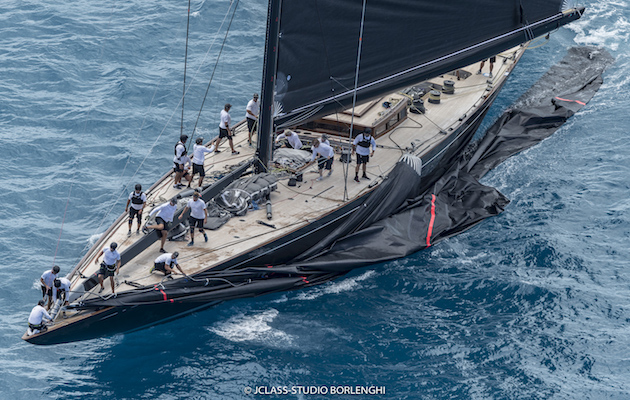
There was a loud bang as Svea approached the top mark – the headstay swivel broke and the stay and genoa collapsed. The crew reacted quickly to release the mainsheet and runners and crank on halyards to the foredeck to keep the mast standing. It is hoped Svea will be fixed in time for the J Class Worlds in Newport in August. Studio Borlenghi
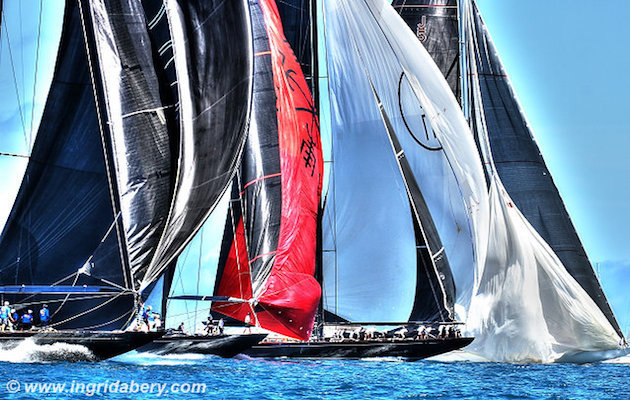
The race to the downwind gate and who can get the vast genoas up and kites down quickest – Ingrid Abery

The red socks of Ranger in support of Emirates Team New Zealand (famously worn by Sir Peter Blake) – Gilles Martin-Raget

Following a poor start and a tense finish to the last race, Lionheart wins the America’s Cup J Class Regatta. It marked triple success for the JH1 team in Bermuda, after also winning their class and the overall prize in the Superyacht Regatta. Some of her Falmouth based crew hoist the Cornish flag in celebration – Ingrid Abery
J Class to hold 2024 World Championships in Barcelona in 2024

September 1, 2023
Image credit:
© Studio Borlenghi / Francesco Ferri.
No history of the America’s Cup is complete without mention of the J Class, the magnificent sloops that competed for the trophy in three editions between 1930 and 1937. Their grace and beauty reflected a time where a booming global economy brought some of the most colourful tycoons to compete for the oldest international sports trophy in the world. Names like Sir Thomas Lipton, Harold S Vanderbilt and Sir Thomas Sopwith graced a period that is known as the ‘Golden Age’ of the America’s Cup before the realities of the aftermath of the Second World War, saw the smaller, more affordable 12 Metre Class replace the J Class.
In modern times the J Class has thrived with owners either restoring or building new to old lines drawn but never constructed and to see one of the yachts in person is to witness sailing and racing at its very finest. With the America’s Cup in Barcelona in October 2024, the class have been welcomed by America’s Cup Events to host their World Championships between 7-11 th October 2024 with a practice regatta on the 3-4 th October 2024. The magnificent fleet have been allocated space in the Port Vell Harbour and will be a welcome sight for spectators and enthusiasts of the America’s Cup.
Speaking about the J Class coming to Barcelona, Grant Dalton, CEO of America’s Cup Events commented: “When the idea was first suggested, it was one of the easiest decisions ever to make. The J-Class are integral to the history, legend and fascination of the America’s Cup and we are very grateful to the Class Association and the Owners for taking the opportunity to host their World Championship in Barcelona at the time of the 37 th Match. Seeing those boats being raced just off the Barcelona waterfront will be a spectacle for everyone on the water or watching from the shoreline – we cannot wait to see them in action.”
The J Class fleet has grown in popularity in recent years and the fleet includes Topaz (J8), Ranger (J5), Svea (JS1), Velsheda (JK7), Shamrock V (JK3), Rainbow (JKZ1), Hanuman (JK6) and Lionheart (JH1). The Class Association is seeking a commitment from as many owners as possible with five confirmed to date and others working the America’s Cup into their busy global schedules.
Hosted by the Real Club Nàutic de Barcelona, situated right in the heart of the Port Vell, the club is looking forward to a fabulous J Class regatta in the city, with Jordi Puig, President of the Yacht Club saying: “T he opportunity to host the historic J Class for their World Championships in 2024 is something that myself and all the members of RCNB are immensely looking forward to. These yachts with their remarkable history both in the America’s Cup and into the modern era are one of the true wonders of the sailing world and will draw much attention when they arrive in Barcelona whilst acting as an integral part of the America’s Cup celebrations.”
Stuart Childerley, Class Secretary of the J Class, is delighted to be in the heart of the America’s Cup event in Barcelona 2024 saying: “ We are extremely grateful to Grant and his team for smoothing the passage to be included in the America’s Cup regatta where the DNA of our fleet essentially lies, and we look forward to playing a central part in the programme both on and off the water. The Owners and Class Association are excited to hold our World Championships in Barcelona which will be the highlight of our season after the Maxi Worlds in Porto Cervo during September 2024 and the Mahon regatta in May 2024. The boats will arrive to the Port Vell and be situated right in the heart of the superyacht basin giving spectators a fantastic opportunity to see these historic yachts up close.”
Details of the 2024 World Championships in Barcelona will shortly be available on the J-Class Association website www.jclassyachts.com and circulated to Owners and Owner’s Representatives in due course.

This site uses cookies to enhance your experience. By continuing to browse the site, you consent to the use of cookies. View our Privacy Policy for more information.

COMMENTS
J Class yachts Velsheda, Topaz and Svea downwind legs. The J Class is one of several classes deriving from the Universal Rule for racing boats. The rule was established in 1903 and rates double-masted racers (classes A through H) and single-masted racers (classes I through S). From 1914 to 1937, the rule was used to determine eligibility for ...
J Class yacht Velsheda sailplan. LOA: 39.25m/128ft 9in · LWL: 27.8m/91ft 3in · Beam: 6.57m/21ft 7in · Disp: 180 tonnes. Original lines: Charles E Nicholson. Modified design: Dykstra Naval ...
Yachts. In total nine J Class yachts are currently active, including three original surviving Js - Velsheda, Shamrock and Endeavour - and six replicas that have been built since 2003; Ranger, Rainbow, Hanuman, Lionheart, Topaz and Svea.
The J Class Association was founded in 2000 to protect the interests of the Class, present and future, and organises an annual calendar of racing for these magnificent yachts. 2024 Calendar. 19-22 June.
In total nine J Class yachts are active now with six replicas having been built since 2003; Ranger, Rainbow, Hanuman, Lionheart, Topaz and Svea. The J Class Association. The J Class Association (JCA) was founded to protect the interests of the Class, present and future. Among its responsibilities it monitors and agrees the veracity of designs ...
The J Class - so named because it was the letter allocated to its particular size by the Universal Rule to which the yachts were built (K and M Class yachts were, for example, shorter on the ...
J Class Regatta Falmouth Training. Discover J Class yachts with Yachting World. From race results to yacht profiles and videos, we have the definitive guide to the 2015 J class calender.
Ranger is a 41.55 metre replica of the J Class yacht of the same name, which was built for the 1937 America's Cup by a syndicate led by railroad heir Harold Vanderbilt. Starling Burgess and Olin Stephens had been asked to produce eight sets of lines and the one selected as most suitable for the conditions expected off Newport, Rhode Island — design number 77C — was one of Burgess ...
The sixth J-Class yacht to be built, and the second built on British soil was Velsheda. She was the only J not built as a contender for the America's Cup. Her owner, WL Stephenson, who previously owned White Heather II, the 23-Metre converted to rate as a J-Class in 1930, had Velsheda built in steel in 1933 at the Camper & Nicholson yard.
J Class Yachts. Go inside the world of the iconic J Class yachts with reports on board these famous vessels, interviews with their owners and coverage of the J Class World Championships. Boat International is the official media partner of the J Class Association. Editorial Features. Svea: Inside the newest member of the J Class fleet.
The J-Class website points out that there are 10 unbuilt J designs from the 1930's, so the possibilities for more J-Class yachts are intriguing. Yachting World reported in May, 2003, that construction was underway on a yacht replicating the famous G.L Watson design Britannia. Photos showed a nearly completed hull at Solombala Shipyard, in ...
The J Class has its roots in the oldest international yacht race in the world, The America's Cup. This International Event was born from a race around the Isle of Wight, hosted by the Royal Yacht Squadron and called the R.Y.S. £100 Cup (a.k.a. One Hundred Sovereigns Cup). 1851 - 1928. 1929 - 1937.
Published on June 26th, 2017. J Class yachts, which reigned supreme in the 1930s, are making a thrilling comeback, with restorations, new builds and the biggest fleet the class had ever seen at ...
Owning a piece of history is quite another. That opportunity awaits you, as the famed J Class Endeavour is on the market. To see the 130-foot (39.56-meter) Endeavour, it's impressive to realize she dates back to 1934. The English aviation entrepreneur and yachting enthusiast Sir Thomas Sopwith commissioned her with one goal: win the America ...
With the exception of Velsheda, all the original Js were built for the purpose of America's Cup racing. From 1929 to 1937, 20 J Class yachts were designed. Ten of these were built, and six raced ...
Silhouetted against the Mediterranean sunset, Svea's overhangs are awesome to the point of outrageousness. Her original profile was based on an analysis of the development of the J Class after the 1936 match racing series.. The Swedish naval architect and boatbuilder Tore Holm, famous for his Six Metre and Eight Metre class racing yachts, had turned his pencil to the far bigger Js and he set ...
The J-class yacht Velsheda was designed by Charles Ernest Nicholson and built in 1933 by Camper and Nicholsons at Gosport, Hampshire. She was built for businessman William Lawrence Stephenson and between 1933 and 1936, she won many races and competed with other yachts of her era such as Britannia, Endeavour and Shamrock V. ...
Svea is the newest J Class yacht in the current fleet and was launched in January 2017. At 143ft/43.6m Svea has the longest LOA by 15cms. Her original designs were drawn in 1937 by Swedish Olympian and renowned 6 and 8 Metre boat designer Tore Holm along with compatriot boatbuilder Gustav Plym, but war put paid to any hopes of a Swedish America's Cup challenge.
But J Class yachts remain sensational to sail and mesmerising to watch. The launch of the latest J Class yacht Svea this January takes the current fleet up to nine. That's a collective weight of ...
J Class Yachts for Sale. SuperYacht Times has compiled the largest fleet of yachts for sale. Our data analysts gather valuable information about every superyacht larger than 24-metres currently for sale. With hundreds of yacht sales and transactions per year, the yachting market is a challenging one, and that's why SuperYacht Times has built ...
Svea, the newest addition to the now nine-strong J Class fleet, is one of the most outstanding new yachts of modern times - a harmonious meeting of historic and modern design; a blend of J Class ...
Best Multipurpose Stern: Bering B165. Turkish boatbuilder Bering Yachts revealed details of its new 162-foot flagship explorer yacht, the B165, at the Dubai International Boat Show in March. The ...
The J Class also performed a stunning exhibition race on the America's Cup course on the Great Sound on Saturday, shortly before the first America's Cup match, for the thousands of fans in the ...
The Owners and Class Association are excited to hold our World Championships in Barcelona which will be the highlight of our season after the Maxi Worlds in Porto Cervo during September 2024 and the Mahon regatta in May 2024. The boats will arrive to the Port Vell and be situated right in the heart of the superyacht basin giving spectators a ...